After a period of uncertainty, NASA’s Voyager 1 spacecraft is once again transmitting valuable data on its status and health, marking the first time in five months that such information has been received. The historic spacecraft, located more than 15 billion miles from Earth, had stopped sending readable data on November 14, 2023, despite indications that it was still functioning and receiving commands.
The issue was traced to a malfunction in one of the spacecraft’s three onboard computers, specifically the flight data subsystem (FDS). This subsystem is crucial as it packages the science and engineering data before transmission to Earth. The problem was pinpointed to a faulty chip within the FDS, responsible for storing part of the system’s memory and some essential software code. This malfunction made the data sent back to Earth unusable.
In response, engineers at NASA’s Jet Propulsion Laboratory devised a strategy to circumvent this setback by relocating the affected code to other parts of the FDS memory. However, no single part of the memory was sufficient to hold the entire code, necessitating its division and distribution across several areas. This required careful adjustments to ensure the relocated code would function seamlessly as a whole.
On April 18, the team implemented these changes by sending the newly located code responsible for engineering data back to the FDS. It took a radio signal approximately 22.5 hours to travel the vast distance to Voyager 1 and another 22.5 hours for the response to return to Earth. By April 20, the success of this modification was confirmed when the team was able to assess the spacecraft’s health and status for the first time since the issue began.
The next steps involve similarly relocating and adjusting other parts of the FDS software, with the aim of resuming the transmission of science data. This progress brings a new lease of life to the Voyager 1 mission, which, alongside its twin Voyager 2, remains the only spacecraft to have ventured into interstellar space.
Voyager 2 continues to operate without issues, having been launched over 46 years ago alongside Voyager 1. These spacecraft have made significant contributions to our understanding of the outer planets before embarking on their current interstellar journey.


